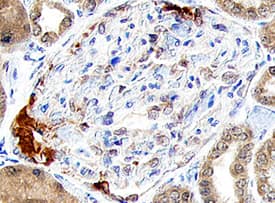Human Renin Propeptide Antibody
R&D Systems, part of Bio-Techne | Catalog # MAB4447

Key Product Details
Species Reactivity
Validated:
Cited:
Applications
Validated:
Cited:
Label
Antibody Source
Product Specifications
Immunogen
Leu24-Arg406
Accession # P00797
Specificity
Clonality
Host
Isotype
Scientific Data Images for Human Renin Propeptide Antibody
Renin in Human Kidney.
Renin was detected in immersion fixed paraffin-embedded sections of human kidney using 15 µg/mL Mouse Anti-Human Renin Propeptide Monoclonal Antibody (Catalog # MAB4447) overnight at 4 °C. Before incubation with the primary antibody tissue was subjected to heat-induced epitope retrieval using Antigen Retrieval Reagent-Basic (Catalog # CTS013). Tissue was stained with the Anti-Mouse HRP-DAB Cell & Tissue Staining Kit (brown; Catalog # CTS002) and counterstained with hematoxylin (blue). View our protocol for Chromogenic IHC Staining of Paraffin-embedded Tissue Sections.Applications for Human Renin Propeptide Antibody
Immunohistochemistry
Sample: Immersion fixed paraffin-embedded sections of human kidney subjected to Antigen Retrieval Reagent-Basic (Catalog # CTS013)
Western Blot
Sample: Recombinant Human Renin (Catalog # 4090-AS)
Formulation, Preparation, and Storage
Purification
Reconstitution
Formulation
Shipping
Stability & Storage
- 12 months from date of receipt, -20 to -70 °C as supplied.
- 1 month, 2 to 8 °C under sterile conditions after reconstitution.
- 6 months, -20 to -70 °C under sterile conditions after reconstitution.
Background: Renin
Human Renin is a member of the aspartyl proteinase family produced largely in part by the juxtaglomerular cells in the kidney (1). Renin differs from the other members of this class by having a pH optimum near the neutral pH region with native substrates instead of a pH 2.0 to 3.4 range (2). This more neutral pH optimum allows it to be functional in the plasma. Renin also has a very high selectivity for substrates due to a long peptide recognition on either side of the peptide bond undergoing cleavage. An octapeptide substrate was the minimum length to be cleaved by Renin. Renin plays a crucial role in the regulation of blood pressure and salt balance through the cleavage of angiotensinogen, which is the only known physiological substrate of Renin. Renin releases the decapeptide angiotensin I, which in turn is further converted to vasoactive hormone angiotensin II by angiotensin converting enzyme (ACE). Renin is produced as prorenin with 43 pro residues at the N‑terminal of mature Renin. The inactive prorenin becomes activated proteolytically by trypsin, cathepsin B, or other proteinases. Renin is expressed as a precursor consisting of a signal sequence (aa 1‑23), a propeptide (aa 24‑66), and a mature chain (aa 67‑406). The amino acid sequence of human REN shares 100%, 73%, 71% and 67% identity with that of chimpanzee, canine, mouse and rat.
References
- Yokosawa, H. et al. (1980) J. Biol. Chem. 255:3498.
- Fuminaki, S. et al. (2004) in Handbook of Proteolytic Enzymes, Barret, A.J. et al. eds. p. 54.
Alternate Names
Gene Symbol
UniProt
Additional Renin Products
Product Documents for Human Renin Propeptide Antibody
Product Specific Notices for Human Renin Propeptide Antibody
For research use only
